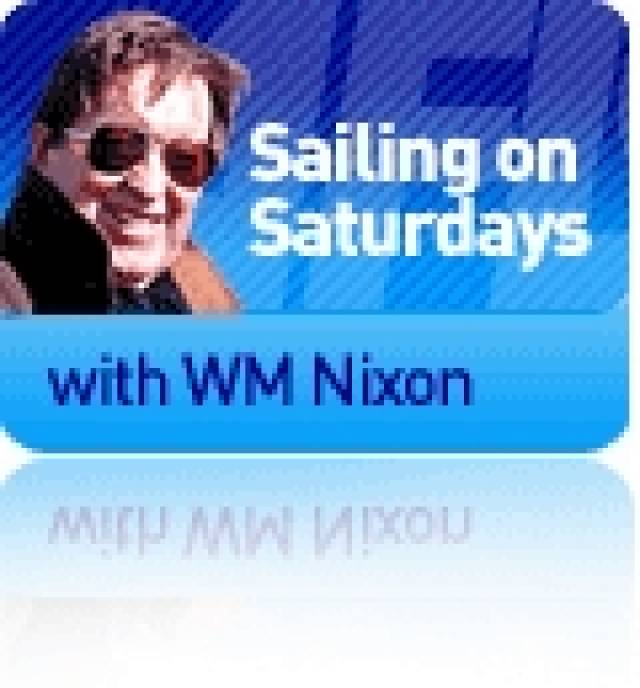#wildatlanticway – There's an elemental quality to Ireland's Atlantic seaboard which can be more than matched by the weather the ocean throws at it. In the recent Transatlantic Race, the participants commented – often forcefully - on the extreme sailing conditions they increasingly experienced as they came within the area which shares the ocean's many and often turbulent moods with our own spectacular West Coast. W M Nixon reflects on the sailing challenges which are integral to the Atlantic experience.
They say you don't need an excess of wind to establish a sailing record. A good strong breeze is all that's required. But the fleet coming across the Atlantic during the first half of July had record-breaking-conditions-plus much more often than they wanted as they got into the northeast section of the ocean where Ireland is the furthest frontier, snug in the lee of Manhattan......
Such conditions day after day cause crews either to shut down, or else go hell for leather. The classic Sparkman & Stephens veteran Dorade – which won the Transatlantic in 1931 - found that, far from being nursed across the sea, she was being driven in a way which would have been unthinkable when she was first put afloat in her superbly restored state three years ago. But there she was, this gallant old boat, running like a thing possessed, and her crew keeping at it as they rolled wildly, dipping boom-end then pole-end, crashing on across the waves at unthinkable speed.
Even the serious biggies often found the going just a bit too much. But at least the twenty-strong crew of the giant new record machine, the hundred footer Comanche under the command of Kenny Read, could not complain that their "big fat girl" needed more wind, which was their mantra after the Sydney-Hobart Race.
Fair play to the Comanche boys, they took the ball and ran with it, and the result is a new world 24-hour monohull record which was finally officially recognized this week. But it was back on July 10th in hard-driving conditions that Comanche started milling early in the morning, and by 0530 on July 11th she'd clocked 618.01 miles, adding just 21.41 miles to the 596.6 miles logged by Torben Grael's Volvo 70 Ericsson 4 back in October 2008.
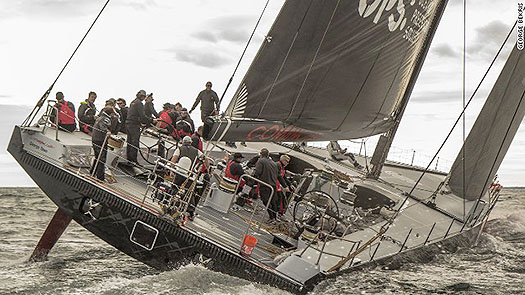
The "big fat girl" finally got the breeze she needs. In the Transatlantic Race, a dose of Irish weather gave the hundred footer Comanche skippered by Kenny Read the power to break the 600-mile barrier for the World Monohull Record, with a 24-hour average speed of 25.75 knots.
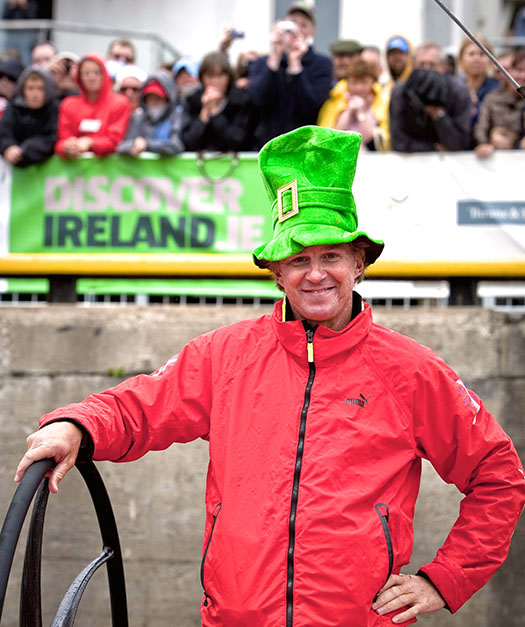 "The People's Skipper" – Kenny Read showed himself game to fool around with the best of them when he was in Galway in June 2009. Photo: Courtesy Failte Ireland
"The People's Skipper" – Kenny Read showed himself game to fool around with the best of them when he was in Galway in June 2009. Photo: Courtesy Failte Ireland
Comanche's new record was set in the kind of conditions they can expect any month of the year in Galway, and it's there that Kenny Read's latest feat will resonate most strongly, as he became the People's Skipper when the Volvo fleet was in the Connacht capital early in the summer of 2009, well able to fool around with the best of them.
But in the end, it was Torben Grael who emerged as the overall winner of that race, and the legendary Brazilian skipper had already been feted in Galway, and taken on a tour of the coastal beauty spots to see why the locals love their sailing so much. The great man observed the delights of Connemara and said it was indeed beautiful. And he greatly admired the enthusiasm of Irish sailors. But personally, if given the choice, he'd prefer somewhere a little warmer and drier, with winds a bit less harsh, if he was selecting a place for a sailing holiday.
Too tough for Torben Grael? It all adds to the mythology of sailing, cruising and offshore racing along Ireland's rugged western seaboard. And it seems more rugged the further you are from it, with most sailors from Belfast, Dublin and Cork viewing it with awe. So to balance the picture, today we'll take a look at cruising along our Atlantic coast as seen by people who actually live there and have their boats based in the heart of it.
The unveiling of the Wild Atlantic Way tourism initiative last year along the entire western seaboard from Malin Head to Kinsale was greeted with mixed feelings by people from elsewhere who love the west of Ireland, and know it intimately. We feared - with justification - that it would result in a succession of tour buses dragging their weary way along tiny roads to get a glimpse of the coast, carrying passengers who would be a sort of landbound equivalent of those cruise liner passengers who don't spend a cent ashore.
But for those who sail along this challenging coastline, rather than struggling with its roads, the term Wild Atlantic Way has an altogether deeper meaning. So we can give a guarded welcome to a new cruising guide which looks at it from a sensible and seamanlike perspective, though admittedly still trading on the recognition which the brand "Wild Atlantic Way" conveys.
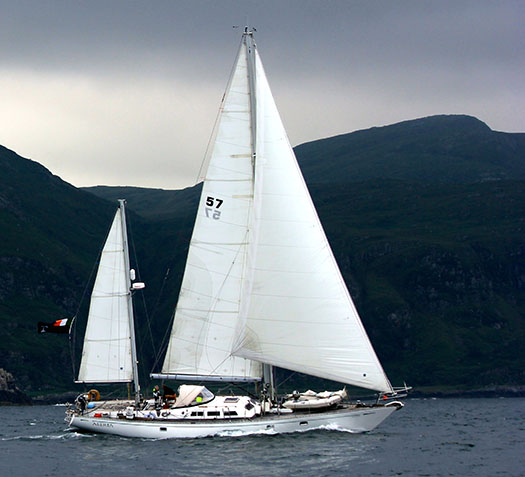
Alex and Daria Blackwell's Clew Bay-based Aleria is a Bowman 57 ketch
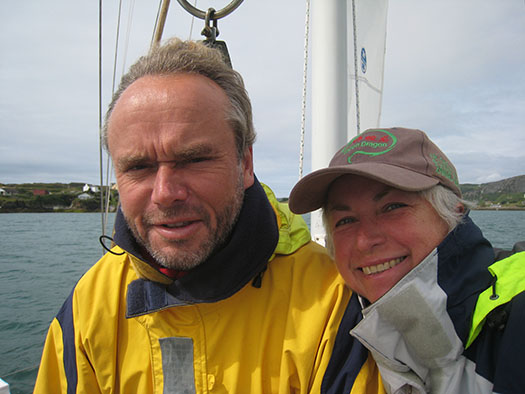
Atlantic seaboard boat people – Alex and Daria Blackwell
Alex and Daria Blackwell live on the shores of Clew Bay in Mayo, and sail the very handsome Holman & Pye-designed Bowman 57 Aleria, with which they've crossed the Atlantic three times. She's American, while he's Irish with a solid background in international seafaring at many levels. From their home, they run a desktop publishing operation, White Seahorse, which has produced a number of books on several topics, the most recent in an eclectic list being Cruising the Wild Atlantic Way, which is aimed at helping newcomers to "Discover Europe's Gem, the Wild West of the Emerald Isle".
You'll rightly deduce that it's aimed mainly at the American market, but I've found it fascinating to read not only for its many nuggets of very useful and specific information, but also because it's written from the point of view of people who see everything from the Clew Bay perspective.
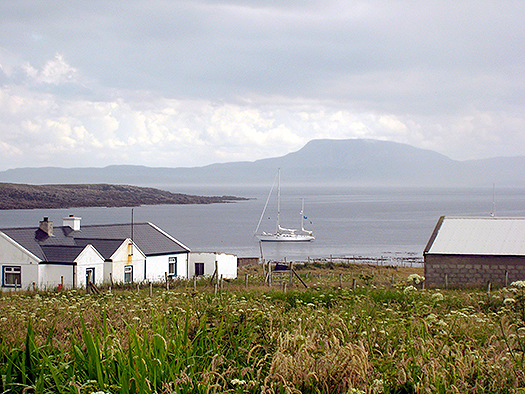
"Doing the research". Aleria at Tory island in Donegal. Photo: A & D Blackwell
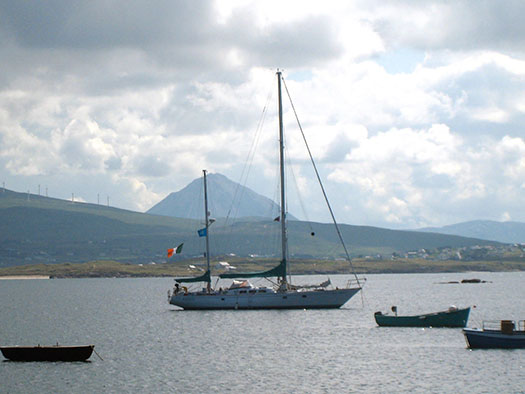
Island hopping in the northwest. Aleria at Gola island in Donegal, with the unmistakable peak of Errigal beyond. Photo: A & D Blackwell.
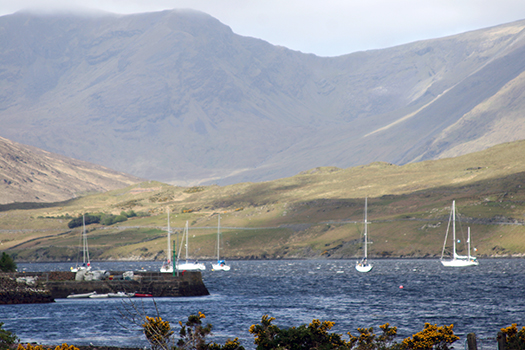
Big country. Aleria and other cruisers anchored in a breeze of wind off Leenane at the head of the fjord-like Killary Harbour. Photo: A & D Blackwell
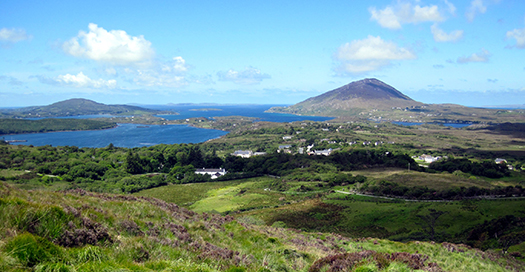
Connemara – the Land of the Sea. Photo: A & D Blackwell
Thus although the good people of Kinsale may think of their beautiful and characterful port town as the hub of the universe, they might be a bit miffed to discover that up in Clew Bay aboard the good ship Aleria, Kinsale and Crosshaven are seen as being at the very tail end of the Wild Atlantic Way, and barely worthy of consideration.
Indeed, I don't think it's unfair to suggest that the book gives the impression that aboard Aleria, the reckoning is that anything south of Dingle or east of Malin Head is not really for serious seafarers with a taste for Ireland's western coast. Donegal has to be given a certain respect as it's even more rugged than Mayo. But south of the Blaskets, you get the feeling they consider it no more than the lotus lands.
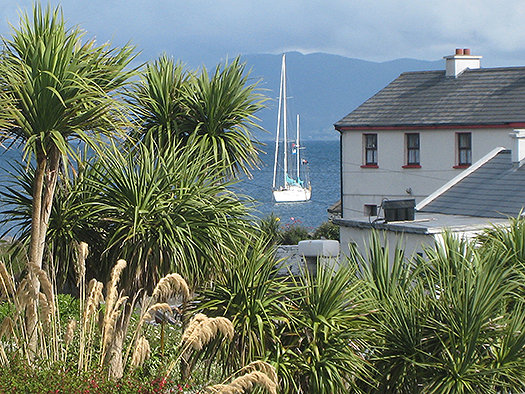
Expect the unexpected – a glimpse of Aleria seen from shore at Inishturk. Photo: A & D Blackwell
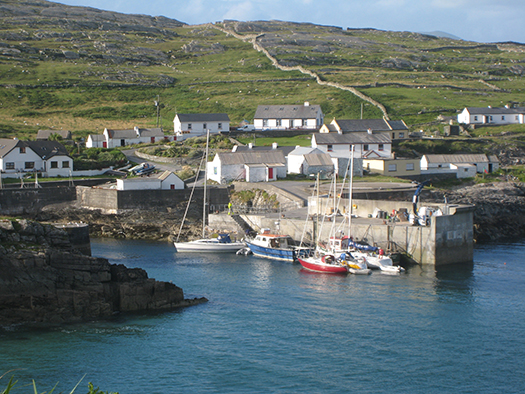
The tiny harbour at Inishturk is too small to accommodate Aleria, but other smaller cruisers manage to find a berth. Photo: A & D Blackwell
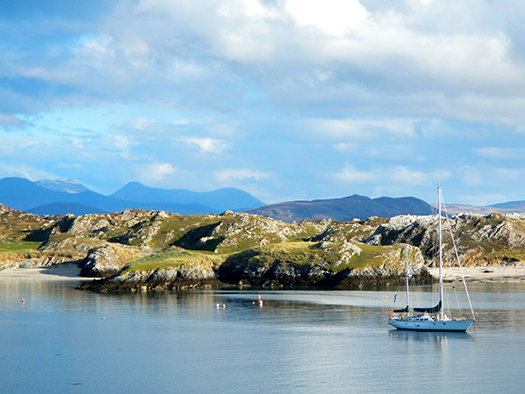
Paradise. Aleria in the anchorage at Inishbofin, with the Twelve Bens of Connemara in the distance. Photo: A & D Blackwell
And though they've sailed many miles on dozens of coastlines, you get the impression that Aleria's ship's company reckons you can find everything you really need in and around the islands between Clew Bay and Slyne Head, with Inishbofin and Inishturk coming out tops. And as both those places are within a comfortable day sail of their home anchorage, unlike visitors from distant ports who often hasten by hasten by, they – on the contrary - can linger and savour the moment.
It's profusely illustrated, the selection of photos we have here being only a tasting. It is what it sets out to be – a very useful introduction and a mine of information for anyone thinking of cruising Ireland's west coast, whether from home or abroad. But as it is selective in its ports visited, it doesn't try to replace the Sailing Directions of the Irish Cruising Club (of which Alex Blackwell is a member), which continue to be unrivalled for their sheer depth and breadth of information about virtually everywhere on the coast.
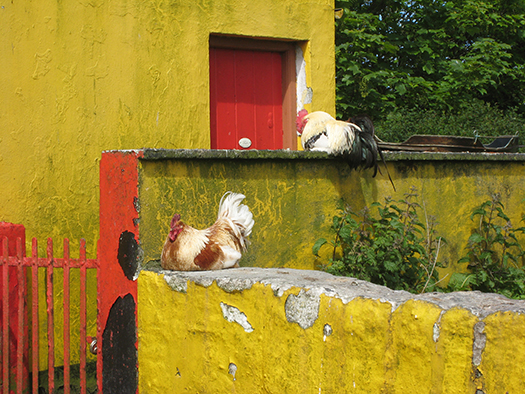
Queue for the loo? Island life, as spotted in the Aran Islands while cruising Aleria on the Wild Atlantic Way. Photo: Daria Blackwell
There's really only one quibble. Cruising the Wild Atlantic Way is very linear in its steady progress round the coast from Lough Swilly to Cork Harbour. But some cruising folk develop a fixed mindset as their cruise progresses, such that they always require their Chartplotter to be set so that the boat's course is seen as heading towards the top of the screen, regardless of where North might be. So the Blackwells are going to have to publish a companion volume with the route in reverse, in which The Wild Atlantic way is cruised from Cork Harbour to Lough Foyle.
Another quibble might be that not everyone will be coping with the wayward conditions of the Atlantic seaboard in a very well found 57ft ketch. In fact, I'd go along with those who might think Aleria is just a bit too big to get the full benefit of many of Ireland's smaller anchorages and ports which are accessible to a 30-footer, whatever about the sheer joy she provides in rapid and comfortable passage-making across the broad Atlantic.
So for others, cruising the Wild Atlantic Way might be a slightly different experience. Just to set the balance right, here's a rough and ready email which has been circulating recently from the owner of a 27-footer from Galway Bay Sailing Club. He had been trying to get south in the horrible weather of recent weeks for a family reunion in Baltimore. The message is headed:
Galway Bay Escape Committee Member Stuck
"Ortac is being held to ransom by the weather in Knightstown in Valentia. Alan and I spent nine days aboard doing little but mending stuff we had broken in our attempts to escape.
On our first try, we blew out the genoa off Bray Head (the southwest headland of Valentia Island). It took Alan two days crouched in the companion way with a borrowed needle and palm to stitch it together. On another try, I thought that praying might help. So I took myself off to the little chapel I have on board, and tried talking to God on the big white telephone.
It did no good, and the two female crew that we had enlisted for the trip (they were friends from the local sub-aqua club) convinced Alan to turn back. Oh how I loved those words: "Turn back". Back at the Knightstown pontoon, we plotted the way points for Castletownbere next day, and then on a visit ashore for refreshment, watched with joy as Evelyn Cusack smiled at us from the TV in the hotel bar, and pointed to the weather map showing light westerly breezes with sun and high temperatures for the foreseeable future.
The next day we got well beyond Bray Head, climbing over the four metre swell, only to be hit with a line of squalls screaming in from the Southwest. We plugged on until, after three hours of misery, we both agreed that it would be madness to continue. The options along this bit of coast with a sou'westerly blowing are few, so we beat a retreat back to Knightstown and the security of its pontoon.
Time was now running out if I was to meet the grandchildren in Baltimore. And even if I made it, the remaining days looked pretty bad. So Alan went home and I got a succession of buses to join the family.
I am planning to return some time (before Christmas) if the weather improves, and will take Ortac for a gentle cruise up the Shannon.
Capt. (Down But Not Out) Ron"
As you can see from the photo, Ortac is not quite in the Aleria league. She's a MacWester 27, and her skipper Ron Marson – who is well into the Free Bus Pass League - is in the self-named Nervous Novices division in the cruising section in Galway Bay Sailing Club.

The Macwester 27 Ortac. Things haven't quite gone according to plan for her cruising on the Wild Atlantic Way this year, but there's still time for her gallant skipper and crew to save the season
But while thing haven't quite gone according to plan this year, you never know what Ron might yet pull out of the 2015 season. Last year he completed a round Ireland cruise despite setbacks and crew problems which would have dissuaded a man of lesser spirit, and last November he was very deservedly awarded the GBSC Cruising Trophy for his log.
It provides an entertaining account of a little boat and crew determinedly on a big project together. Between them, they personify the spirit of the west of Ireland, where things are seen differently. It's a wonderful place. But it's not for the faint-hearted.
You can buy a copy of 'Cruising the Wild Atlantic Way' by Daria Blackwell and Alex Blackwell online HERE



























